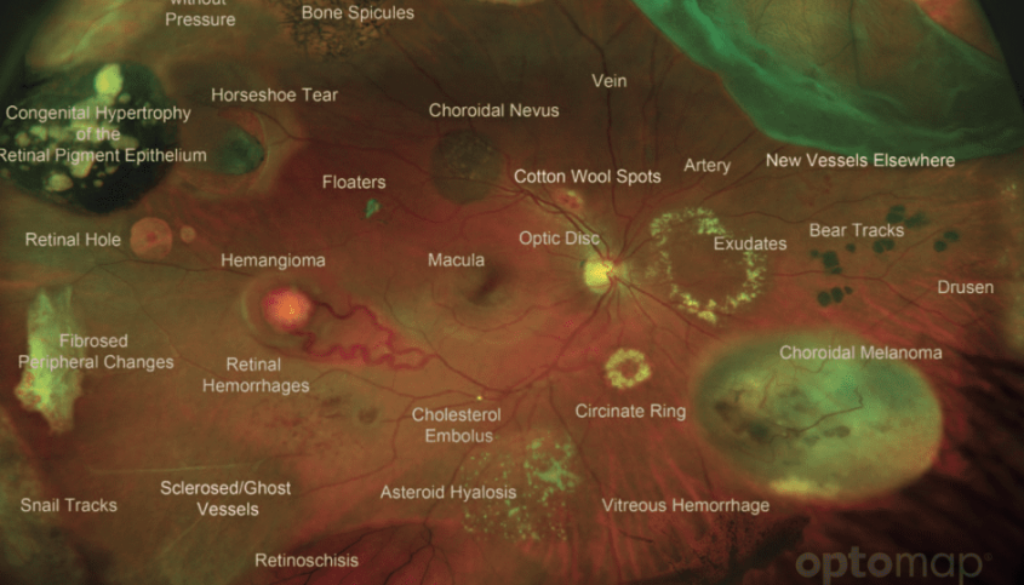5 Benefits of Getting a Retinal Photo at your Eye Exam
5 Benefits of getting a Retinal Photo at your next Eye Exam
Retinal photos are a relatively new technology in the eyecare field but have been shown to be very helpful in providing great patient care and careful monitoring. The Optomap machine takes images which provide an unprecedented 200-degree view that enables doctors to more effectively detect, monitor, and promote patient health.
West Broward Eyecare is a leading optometrist in Tamarac, FL, and utilizes cutting-edge vision technology, including the Optomax, SMap3D, and Optovue.
- No dilation – Most of the time we can get a good image in both eyes and view nearly all of the retina without dilation. It takes ½ a second to take the photo and has no lasting effects on vision. On some occasions with a poor quality photo or suspicion of possible problem, dilation may be required by your doctor.
- Education – There has never previously been a way for the doctor to show the patient exactly what we are evaluating. As a patient the photos allow you to learn more about a diagnosis by visualizing the exam findings.
- Disease detection – The optomap is an excellent tool for diagnosing diseases. As you can see in the photo, a wide variety of diseases can be found and documented with the retinal photos.
- Monitoring changes over time – Even if everything is normal in your eye today, the photo is a great reference if the doctor believes something has changed over time. They can always look back or compare photos side by side. Imagine not knowing if a mole has grown or changed, but then having an old photo to evaluate.
- Safe for all patients – retinal photos can be taken safely and effectively on every patient from young children to pregnant women (which may not want dilating drops).
Retinal Photos vs. Traditional Dilation
When scheduling your Coral Springs eye exam, you deserve options. Here’s why retinal photography is the modern choice for Tamarac, FL, patients:
Retinal Photos (Optomap®):
-
No Recovery Time: Resume driving, work, or outdoor activities immediately.
-
Broad Coverage: 200-degree view vs. the limited 15-degree view with traditional dilation.
-
Ideal for Busy Lifestyles: Perfect for parents, professionals, and seniors in South Florida.
Traditional Dilation:
-
Occasionally Necessary: Required if Optomap® images are unclear or symptoms suggest deeper issues.
-
Temporary Side Effects: Blurred vision for 4-6 hours, light sensitivity.
Beyond the Eyes: Retinal Photos and Overall Health
Your retina is a window to your overall health. At West Broward Eyecare in Tamarac, FL, retinal photos do more than protect your vision—they safeguard your whole body:
-
Diabetes: Swelling or leaks in retinal blood vessels often signal uncontrolled blood sugar.
-
Hypertension: Narrowed arteries in the retina correlate with high blood pressure risks.
-
Autoimmune Diseases: Inflammation visible in retinal scans may indicate lupus or multiple sclerosis.
A 2022 National Eye Institute study found that 1 in 4 patients with retinal abnormalities had undiagnosed systemic conditions. By combining Optomap® imaging with expert analysis, your Tamarac optometrist can:
-
Share findings with your primary care team.
-
Recommend lifestyle changes or specialist referrals.
Retinal Imaging: Your Shield Against Costly Vision Emergencies in Tamarac
As Dr. Sara Rasekhi, our board-certified ophthalmologist, emphasizes: *”A $49 retinal scan – though not always insured – prevents 87% higher costs versus emergency laser surgery for undetected tears. Tamarac patients typically face $5,200 out-of-pocket for last-minute procedures.”*
Why Tamarac Residents Invest in Retinal Photos:
-
Massive Long-Term Savings: Every $1 spent on retinal imaging prevents $9.50 in future diabetic eye treatment (National Eye Institute, 2024)
-
Insurance Made Simple: 94% of Florida Blue plans cover scans with annual exams – our Tamarac team verifies your benefits before appointments
-
HSA/FSA Friendly: IRS-approved expense for health savings accounts
When to Get Retinal Scans in Tamarac: Your Age-Based Guide
Our Tamarac clinic follows American Optometric Association guidelines for retinal imaging frequency. Your ideal schedule depends on age and risk factors:
-
Under 40
-
Low Risk: Every 2-3 years
-
High Risk: Annual scans
-
-
Ages 40-64
-
Low Risk: Every 2 years
-
High Risk: Every 6-12 months
-
-
65+
-
Low Risk: Annual scans
-
High Risk: Every 3-6 months
-
High Risk = Diabetes, hypertension, or family history of glaucoma
Pediatric Retinal Scans in Tamarac: Protecting Young Vision
Our Tamarac clinic’s child-friendly imaging detects critical issues early:
-
Retinoblastoma signs (97% survival with early detection)
-
Learning-related vision problems via retinal blood flow mapping
-
Genetic conditions like the Best disease
Proven Prep Tips from Tamarac Parents:
- Watch our animated prep video together
- Practice “chin rest games” using home toys
- Book morning visits (happier cooperation)
For Tamarac residents, this means early intervention—turning potential health crises into manageable issues.
Schedule your yearly eye exam today online or by phone and request an Optomap retinal photo!
FAQs
-
A retinal photo is an image of the back of the eye, which allows doctors to assess the retina and detect potential eye diseases without requiring dilation. It is taken with a machine called the Optomap.


